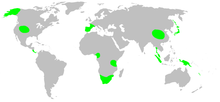

| Long-legged cave spiders
| |
|---|---|

| |
| Telema tenella | |
| Scientific classification | |
| Domain: | Eukaryota |
| Kingdom: | Animalia |
| Phylum: | Arthropoda |
| Subphylum: | Chelicerata |
| Class: | Arachnida |
| Order: | Araneae |
| Infraorder: | Araneomorphae |
| Family: | Telemidae Fage, 1913 |
| Diversity | |
| 16 genera, 104 species | |

| |
Telemidae, also known as long-legged cave spiders, is a family of small haplogyne spiders. Most are cave dwelling spiders with six eyes, though some do not have any eyes at all. There are about 104 described species in sixteen genera.[1]
The legs are long, thin, relatively spineless, and do not have trichobothria. They have three pairs of spinnerets, the longest of which is toward the head. Instead of book lungs, they have two pairs of tracheal spiracles. The elongate abdomen bears a hardened ridge above the pedicel running in a zigzag pattern that is more clearly defined in males than females. The pedipalp on males is oval and bag-like with a thin spermatophore. The female pedipalp does not have a claw.[2]
As of July 2022[update], the World Spider Catalog accepts the following genera:[1]
| Telemidae |
|
|---|---|